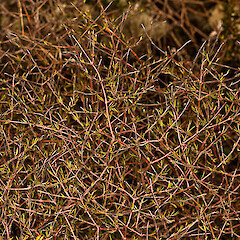Coprosma intertexta
Synonyms
None
Family
Rubiaceae
Flora category
Vascular – Native
Endemic taxon
Yes
Endemic genus
No
Endemic family
No
Structural class
Trees & Shrubs - Dicotyledons
NVS code
The National Vegetation Survey (NVS) Databank is a physical archive and electronic databank containing records of over 94,000 vegetation survey plots - including data from over 19,000 permanent plots. NVS maintains a standard set of species code abbreviations that correspond to standard scientific plant names from the Ngä Tipu o Aotearoa - New Zealand Plants database.
COPINT
Chromosome number
2n = 44
Current conservation status
The conservation status of all known New Zealand vascular plant taxa at the rank of species and below were reassessed in 2017 using the New Zealand Threat Classification System (NZTCS) – more information about this can be found on the NZTCS website. This report includes a statistical summary and brief notes on changes since 2012 and replaces all previous NZTCS lists for vascular plants.
Please note, threat classifications are often suggested by authors when publications fall between NZTCS assessment periods – an interim threat classification status has not been assessed by the NZTCS panel.
- Conservation status of New Zealand indigenous vascular plants, 2017 . 2018. Peter J. de Lange, Jeremy R. Rolfe, John W. Barkla, Shannel P. Courtney, Paul D. Champion, Leon R. Perrie, Sarah M. Beadel, Kerry A. Ford, Ilse Breitwieser, Ines Schönberger, Rowan Hindmarsh-Walls, Peter B. Heenan and Kate Ladley. Department of Conservation. Source: NZTCS and licensed by DOC for reuse under the Creative Commons Attribution 4.0 International licence.
2017 | At Risk – Declining | Qualifiers: DP, Sp
Previous conservation statuses
2012 | At Risk – Declining | Qualifiers: DP, Sp
2009 | At Risk – Relict | Qualifiers: De, DP, RF, Sp
2004 | Sparse
Brief description
Bushy reddish wide-angled tangled shrub with very small needle-like leaves. Leaves 10mm long, often curved sideways, sometimes with tiny hairs on upper surface (lens needed), margin red. Very small hair-fringed triangular flap on stem between base of leaf pairs. Fruit small, white or pale blue.
Distribution
Endemic. South Island, eastern from the Saxton River (Marlborough) south to Otago
Habitat
A species of the eastern South Island dry intermontane basins where it usually grows in grey scrub overlying old moraines, coarse alluvium, boulder piles and or rock outcrops.
Wetland plant indicator status rating
Information derived from the revised national wetland plant list prepared to assist councils in delineating and monitoring wetlands (Clarkson et al., 2021 Manaaki Whenua – Landcare Research Contract Report LC3975 for Hawke’s Bay Regional Council). The national plant list categorises plants by the extent to which they are found in wetlands and not ‘drylands’. The indicator status ratings are OBL (obligate wetland), FACW (facultative wetland), FAC (facultative), FACU (facultative upland), and UPL (obligate upland). If you have suggestions for the Wetland Indicator Status Rating, please contact: [Enable JavaScript to view protected content]
UPL: Obligate Upland
Rarely is a hydrophyte, almost always in uplands (non-wetlands).
Detailed description
Dioecious, erect, somewhat fastigiate, extensively to sparingly branched, suckering shrub forming thickets up to 2 x 2 m. branches and branchlets fastigiate, filiramulate divaricate; branchlets at first finely puberulent becoming glabrous with age; bark initially pale-grey maturing dark brown. Leaves on short brachyblasts or in opposite pairs or near sessile fascicles. Interpetiolar stipules shortly-sheathing, broadly oblong triangular, obtuse with an attentuated apex surmounted by a single, deciduous apical denticle, denticles otherwise 3-6 all deciduous, outer surfaces finely ciliolate, undersides sparingly so, stipular collar-margins chartaceous when dry. Petioles slender 0.5-2 mm long. Leaves 7- 15 x 1-2 mm, darg grey-green to red-brown or purple-green, narrow-oblong to narrowly obovate-oblong, often slightly falcate, subacute, apiculate, margins initially puberulent, reddish; midrib and sometimes secondary veins evident.
Manaaki Whenua Online Interactive Key
Similar taxa
Most similar to Coprosma elatirioides de Lange et A.Markey from which it differs by its upright, non-lianoid shrub habit, much thinner leaves with acute leaf apices, and white translucent fruits (often with dark blue streaks or flecks). The stipules of C. intertexta differ from C. elatirioides by the sparse or complete absence of hairs on the upper surface, their shortly sheathing nature (< 1/4 the height of the whole stipule), by the stipule exceeding the sheath, and by its attenuated apex surmounted by a single terminal deciduous denticle. Either side of the apical denticle on the stipule sheath are 3-6 rather than 1-4 deciduous denticles. Finally the thin stipular collar-margins of C. intertexta are distinctly chartaceous rather than coriaceous when dry. Coprosma elatirioides is a species of open mesotrophic to oligotrophic wetlands and C. intertexta which is wholly allopatric from it, is a species of the drier, eastern intermontane basins where it mainly grows in grey scrub communities.
Flowering
October - February
Flower colours
Green, Yellow
Fruiting
July - December
Life cycle
Fleshy drupes are dispersed by frugivory (Thorsen et al., 2009).
Propagation technique
Easy from fresh seed, semi-hardwood cuttings and rooted pieces (this species suckers)
Threats
A local endemic with a naturally sparse distribution, perhaps most common in the inland basins of Canterbury and Otago
Etymology
coprosma: From the Greek kopros ‘dung’ and osme ‘smell’, referring to the foul smell of the species, literally ‘dung smell’
intertexta: Intertwined
Attribution
Fact sheet prepared by P.J. de Lange for NZPCN (1 June 2013)
References and further reading
Thorsen, M. J.; Dickinson, K. J. M.; Seddon, P. J. 2009. Seed dispersal systems in the New Zealand flora. Perspectives in Plant Ecology, Evolution and Systematics 11: 285-309
NZPCN Fact Sheet citation
Please cite as: de Lange, P.J. (Year at time of access): Coprosma intertexta Fact Sheet (content continuously updated). New Zealand Plant Conservation Network. https://www.nzpcn.org.nz/flora/species/coprosma-intertexta/ (Date website was queried)






